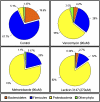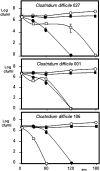Effect of broad- and narrow-spectrum antimicrobials on Clostridium difficile and microbial diversity in a model of the distal colon
- PMID: 20616009
- PMCID: PMC3063588
- DOI: 10.1073/pnas.1001224107
Effect of broad- and narrow-spectrum antimicrobials on Clostridium difficile and microbial diversity in a model of the distal colon
Abstract
Vancomycin, metronidazole, and the bacteriocin lacticin 3147 are active against a wide range of bacterial species, including Clostridium difficile. We demonstrate that, in a human distal colon model, the addition of each of the three antimicrobials resulted in a significant decrease in numbers of C. difficile. However, their therapeutic use in the gastrointestinal tract may be compromised by their broad spectrum of activity, which would be expected to significantly impact on other members of the human gut microbiota. We used high-throughput pyrosequencing to compare the effect of each antimicrobial on the composition of the microbiota. All three treatments resulted in a decrease in the proportion of sequences assigned to the phyla Firmicutes and Bacteroidetes, with a corresponding increase in those assigned to members of the Proteobacteria. One possible means of avoiding such "collateral damage" would involve the application of a narrow-spectrum antimicrobial with specific anti-C. difficile activity. We tested this hypothesis using thuricin CD, a narrow-spectrum bacteriocin produced by Bacillus thuringiensis, which is active against C. difficile. The results demonstrated that this bacteriocin was equally effective at killing C. difficile in the distal colon model but had no significant impact on the composition of the microbiota. This offers the possibility of developing a targeted approach to eliminating C. difficile in the colon, without collateral damage.
Conflict of interest statement
Conflict of interest statement: B.K. is Chief Executive Officer of Alimentary Health Ltd., a company that has obtained rights to the thuricin antimicrobial from the research institutes of the other authors involved in this study.
Figures




References
Publication types
MeSH terms
Substances
LinkOut - more resources
Full Text Sources
Other Literature Sources
Medical
Molecular Biology Databases

